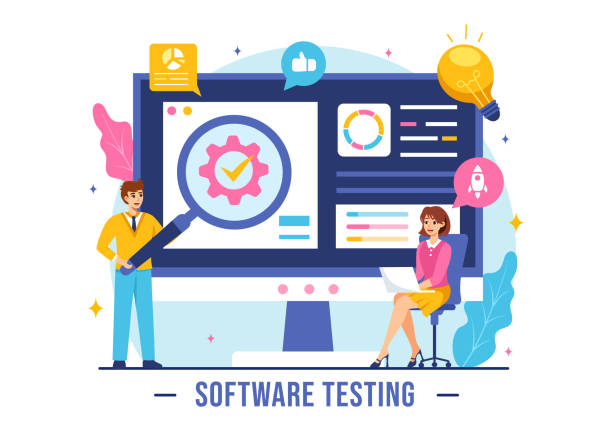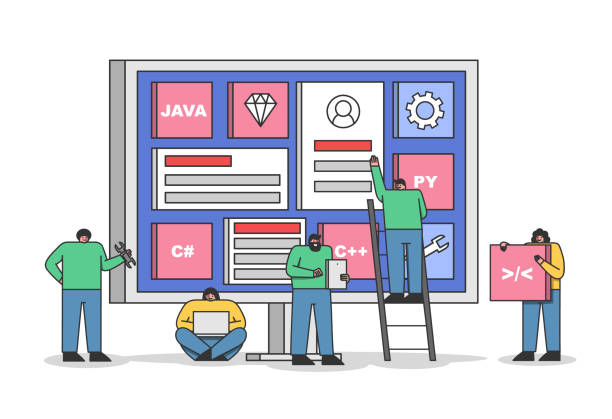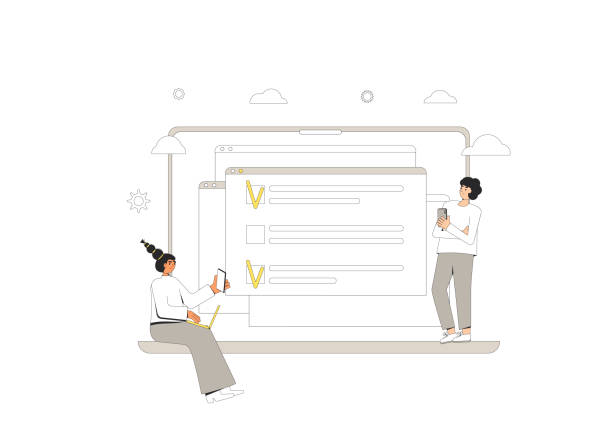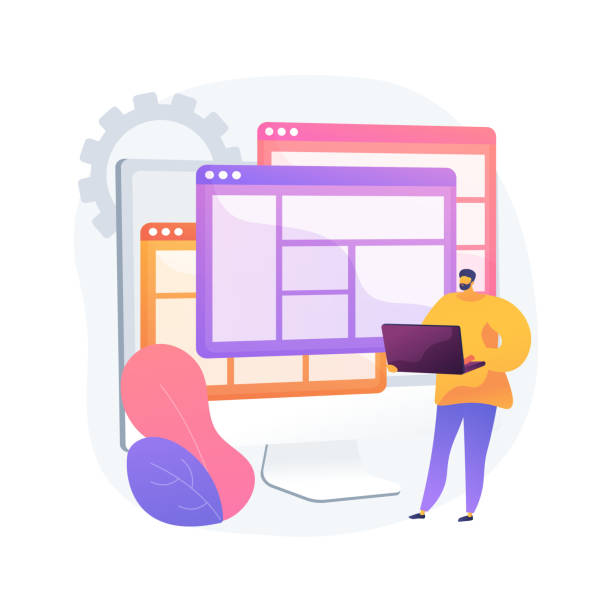Importance of Secure Website Design in the Digital Age

In today’s world, where digital boundaries are rapidly expanding, secure website design is no longer a luxury choice, but a fundamental necessity for every business and organization.
With a significant increase in the number of online users and the volume of information exchange, the web platform has become an attractive target for cyber attacks.
Website security not only ensures the protection of sensitive user information and company data but also significantly increases user trust.
An insecure website can lead to data loss, financial damages, loss of brand reputation, and even legal consequences.
It is an undeniable fact that security threats are becoming more complex and sophisticated every day, highlighting the need for a comprehensive approach to secure website design more than ever.
An educational approach in this area is crucial, as many vulnerabilities stem from a lack of awareness among developers and website administrators.
Any negligence in this area can open an organization’s doors to attackers.
A comprehensive approach to secure website design requires a deep understanding of the nature of threats and the application of best practices throughout all stages of the software development lifecycle.
From initial planning and design to implementation, deployment, and maintenance, security principles must be at the core of the thinking.
This section provides an explanatory look at why website security is important.
Ultimately, the main goal of emphasizing secure website design is to create a reliable online ecosystem resistant to attacks, so that users and businesses can continue their activities with peace of mind.
Every day, news of a new cyber-attack is heard, indicating that no organization is immune to these threats.
Therefore, investing in secure website design is an investment in the future and sustainability of your business.
Does your current website reflect your brand’s credibility as it should? Or does it scare away potential customers?
RasavWeb, with years of experience in designing professional corporate websites, is your comprehensive solution.
✅ A modern, beautiful website tailored to your brand identity
✅ Significant increase in lead generation and new customers
⚡ Contact RasavWeb now for a free corporate website design consultation!
Common Web Vulnerabilities and Prevention Strategies

On the path to secure website design, understanding common web vulnerabilities is a fundamental step.
Most cyber-attacks exploit known weaknesses categorized by the OWASP (Open Web Application Security Project) organization in its “OWASP Top 10” list.
This list includes vulnerabilities such as SQL Injection, Cross-Site Scripting (XSS), Cross-Site Request Forgery (CSRF), and Broken Authentication.
SQL Injection occurs when attackers send malicious SQL code to the database through website inputs, allowing them to manipulate or extract data.
To prevent it, using Prepared Statements and parameterizing queries is essential.
XSS allows attackers to execute client-side code (such as JavaScript) in the victim’s browser, which can lead to cookie theft or page content modification.
The solution is to carefully filter and validate all user inputs, as well as encode outputs.
CSRF tricks users into performing unintended operations on websites where they are authenticated, without their knowledge.
Anti-CSRF tokens and checking the Referer header can prevent this attack.
Broken authentication includes weaknesses in session management, weak passwords, or insecure password recovery.
Supporting multi-factor authentication (MFA), securely storing passwords using strong hashing functions, and proper session management are vital for combating this vulnerability.
A deep understanding of these vulnerabilities and implementing preventive solutions requires an analytical and explanatory approach to design websites with the highest level of security.
A multi-layered defense approach forms the basis of secure website design, and only by addressing each of these weaknesses can this goal be achieved.
Understanding these vulnerabilities helps developers adopt a secure approach from the outset when coding.
Principles of Secure Coding and Layered Architecture

Secure coding and adopting a layered architecture form the backbone of secure website design.
This section delves into the technical aspects of website design and development with a focus on security.
Input Validation is a fundamental principle; never trust user input and always sanitize and filter all data before processing or storing it.
This includes checking data type, length, format, and allowed content.
Output Encoding is equally important; this process prevents code injection by attackers into the user’s browser page.
Using Prepared Statements or secure ORMs is an effective solution for combating SQL injection attacks.
These methods separate input data from SQL commands, preventing them from being interpreted as code.
Session Management must also be handled carefully.
Session IDs should be long, random, and unpredictable, and must be transmitted over HTTPS.
Furthermore, session expiration times should be reasonable, and a new session ID should be issued with each user re-login.
Layered architecture means dividing the system into independent sections, each with its specific tasks, protecting other layers.
This includes Presentation, Business Logic, and Data layers.
By applying security controls at each layer, even if one layer is compromised, the attacker’s access to other sections will be limited.
This approach provides practical guidance for developers looking to implement secure website design from the ground up.
The table below shows the differences between secure and insecure coding practices, which can serve as an educational checklist.
| Feature | Secure Coding | Insecure Coding (Risky) |
|---|---|---|
| Input Validation | Always filters and validates input. | Incomplete or no input validation. |
| Database Access | Uses Prepared Statements or secure ORMs. | Direct string concatenation in SQL queries. |
| Password Management | Stores using strong hashing functions (e.g., bcrypt). | Stores passwords in plain text or weak hashes. |
| Error Handling | Provides generic and uninformative error messages to attackers. | Exposes sensitive technical details in error messages. |
| Session Management | Long, random session IDs transmitted over HTTPS. | Guessable session IDs or transmitted over HTTP. |
Implementing these principles at every stage of development ensures greater website resilience against attacks.
Securing Server and Hosting Infrastructure

To complete the puzzle of secure website design, the importance of securing the server and hosting infrastructure cannot be overlooked.
Even if the website code is flawless, an insecure server can expose the entire system to risk.
“Server Hardening” is a set of measures taken to reduce vulnerabilities and enhance the security of a server.
These measures include removing unnecessary services, closing unused ports, securely configuring firewalls (such as iptables or Windows Firewall), and ensuring all system software and libraries are up to date.
The server operating system, web server (such as Apache or Nginx), database (such as MySQL or PostgreSQL), and any other third-party software must regularly receive security patches.
This is a technical point often overlooked, but it can prevent many known attacks.
Using an Intrusion Detection System (IDS) and Intrusion Prevention System (IPS) can help identify and block malicious traffic in real-time.
These tools monitor network traffic and detect attack patterns.
Choosing a reputable and reliable Hosting Provider also plays a key role in secure website design.
A good host should have strong security infrastructures, a knowledgeable technical support team, and strict security protocols.
Secure configurations for network protocols such as SSH (using SSH keys instead of passwords), FTP (avoiding insecure FTP and preferring SFTP or SCP), and DNS are of high importance.
Furthermore, Network Segmentation can limit attackers’ access to sensitive parts of the system if one section is compromised.
Continuous monitoring of Server Logs to identify suspicious activities is also a vital guidance measure.
Access logs, error logs, and security logs should be reviewed periodically.
Finally, a Secure Deployment strategy, which includes the use of configuration management and automation tools, can reduce human errors and ensure security stability over time.
This comprehensive approach guarantees a secure website design that is robust not only at the software layer but also in the infrastructure.
Is your e-commerce website ready to attract maximum customers and increase sales? RasavWeb transforms your online business with modern and efficient e-commerce website designs.
✅ Increased speed and SEO improvement
✅ Excellent user experience on mobile and desktop⚡ Get a free e-commerce website design consultation from RasavWeb!
User Authentication and Access Management

One of the most crucial aspects of secure website design is robust user authentication and access management.
This section assures users that their personal information and access rights are protected, preventing unauthorized intrusion.
Authentication is the process of verifying a user’s identity, while Authorization determines what resources or operations a user can access after authentication.
For authentication, using strong and unique passwords for each user is essential.
Websites should encourage users to use complex passwords (including uppercase and lowercase letters, numbers, and symbols) and implement password change policies.
Multi-Factor Authentication (MFA) adds a critical security layer; even if a user’s password is compromised, the attacker cannot log in without a second factor (such as a code sent to a phone or a fingerprint).
Password storage must be done securely; never store passwords in plain text.
Instead, use strong, brute-force-resistant hashing functions like bcrypt or Argon2, and always utilize a random and unique “salt” for each password.
Proper Session Management is also of high importance.
Session IDs should be random and unpredictable and must be transmitted via secure cookies (with Secure and HttpOnly flags).
Additionally, sessions should have a reasonable expiration time and be immediately invalidated upon user logout.
Regarding authorization, the Principle of Least Privilege must be observed.
This means granting the minimum possible access to users and systems to perform their tasks.
Using Role-Based Access Control (RBAC) is an effective method for managing access in complex systems.
This section provides an explanatory and educational look at how to protect user accounts and their data on modern websites.
These measures not only prevent unauthorized access but also significantly contribute to the stability and trustworthiness of your secure website design.
Data Encryption and Privacy Protection

Data encryption and privacy protection are considered fundamental pillars of secure website design and directly impact user trust.
In the current era, where concerns about privacy breaches are increasing, every website must ensure that user data is protected at all stages.
Data encryption is divided into two main categories: data in transit and data at rest.
For encrypting data in transit, using the HTTPS protocol with an SSL/TLS certificate is essential.
HTTPS ensures that all communications between the user’s browser and the website server are encrypted, preventing eavesdropping, tampering, or forgery.
This is an industry standard, and most browsers flag websites without HTTPS as insecure.
Regarding data at rest, i.e., data stored in databases or files on the server, using full disk encryption or column-level encryption in the database for sensitive information (such as financial or health data) is recommended.
This measure prevents direct information disclosure even if the server is compromised and files are accessed.
In addition to encryption, compliance with data privacy regulations, such as GDPR (General Data Protection Regulation) in Europe or CCPA (California Consumer Privacy Act) in the United States, is mandatory for many websites.
These regulations impose strict responsibilities on data collectors and processors and strengthen users’ rights to control their personal information.
Implementing explicit consent mechanisms for data collection, providing transparency about how information is used, and enabling users to access, correct, or delete their data are among the requirements of these laws.
The secure website design team must be aware of these regulations and incorporate them into data collection, storage, and processing procedures.
This is a technical and analytical aspect that covers not only technical security but also ethical and legal responsibility.
Ultimately, the goal of encryption and privacy protection is to create a secure and trustworthy online environment where users feel safe and respected.
Periodic Security Testing and Continuous Updates

Secure website design is not a static process; rather, it requires continuous attention and updates.
Security threats are constantly changing and evolving, so periodic security testing and regular updates are the most vital part of maintaining a website’s security.
One of the most important tools in this area is “Penetration Testing”.
In this test, security experts try to identify and exploit system weaknesses using techniques similar to real attackers.
The result of these tests will be a comprehensive report of vulnerabilities and their remediation strategies.
“Vulnerability Scanning” is also an automated tool for quickly identifying known weaknesses in code, server, and infrastructure.
These scans should be performed regularly and systematically.
In addition to automated tests, manual “Code Review” by experienced developers or security experts can uncover vulnerabilities that might not be detected by automated tools.
This process helps identify insecure coding patterns and educates the development team.
“Software Updates” include all parts of the website, such as the server operating system, web server, database, programming language, frameworks, libraries, plugins, and Content Management System (CMS).
Developers should continuously track the release of security patches and apply them immediately after evaluation.
Most successful attacks occur due to outdated software with known vulnerabilities.
This aspect of secure website design requires an informational and guidance approach, as being aware of the latest threats and new security patches is crucial.
The table below provides a suggested schedule for periodic security tests and necessary updates, which can serve as a practical framework for maintaining website security.
| Activity | Description | Suggested Frequency | Responsible |
|---|---|---|---|
| Vulnerability Scanning | Uses automated tools to identify known vulnerabilities. | Weekly/Monthly | Security/Development Team |
| Penetration Testing | Simulates real attacks to discover weaknesses. | Annually/After major changes | External/Internal Expert |
| Code Review | Manual code inspection to find vulnerabilities and insecure patterns. | After every significant change/Quarterly | Development/Security Team |
| OS and Software Updates | Applies security patches for all system components. | Immediately after patch release | System Administrator/DevOps |
| Log Monitoring | Continuous review of logs to identify suspicious activities. | Daily/Weekly | SOC/Security Team |
By implementing these technical approaches, website security can be maintained over time.
Planning for Security Incident Response and Data Recovery

Even with the best approaches to secure website design and continuous testing and updates, the possibility of a Security Incident still exists.
The important thing is how we prepare for such an event and what reaction we show.
“Incident Response Plan” is a vital document that accurately outlines the steps for dealing with a cyber intrusion or attack.
This plan should include stages of preparation, identification, containment, eradication, recovery, and lessons learned.
The identification phase involves continuous monitoring of systems and logs to detect any suspicious activity.
Once an incident is identified, the Containment phase begins, aiming to prevent the attack from spreading and reduce damage.
This might involve disconnecting compromised sections or blocking suspicious traffic.
After containment, the Eradication phase involves completely removing the intrusion agent and related vulnerabilities.
This phase requires thorough Forensic Analysis to understand how the attack occurred.
“Disaster Recovery” and “Regular Backups” are integral components of this plan.
Data should be backed up regularly and in secure, separate locations so that in case of data loss, the system can be restored to its pre-incident state.
This section offers an explanatory and guidance look at these important measures.
Backups should include data, configurations, source code, and databases, and their restorability should be tested periodically.
After recovery, the Lessons Learned phase is very important.
In this phase, the security and development teams should thoroughly review the incident, identify weaknesses, and improve preventive measures to prevent similar attacks from recurring in future secure website design.
Transparent and prompt communication with stakeholders (users, partners, and legal authorities) during an incident is also highly important, albeit with caution regarding the disclosure of sensitive information.
A robust incident response plan not only reduces system downtime but also preserves user trust after an incident.
This demonstrates that the organization is seriously committed to secure website design and protecting its data.
Does your company’s website perform as befits your brand? In today’s competitive world, your website is your most important online tool. RasavWeb, an expert in professional corporate website design, helps you to:
✅ Gain customer credibility and trust
✅ Convert website visitors into customers
⚡ Get a free consultation!
The Role of User Awareness and Security Education

Within the comprehensive framework of secure website design, the human element is often cited as the weakest security link.
Therefore, enhancing user awareness and providing effective security education is as crucial as technical measures.
Attacks such as Phishing, Social Engineering, and Malware often target users, not just technical systems.
A secure website can educate its users about common online threats through educational and engaging content.
This content can include articles on how to create strong passwords, identify phishing emails, the dangers of clicking on suspicious links, and the importance of enabling multi-factor authentication.
Showing real-world examples of attacks and explaining their consequences can be very effective in raising user awareness.
For instance, a “Security FAQ” section or a blog with guidance articles on safety tips can empower users.
Websites can use in-app messages to educate users in real-time, for example, during login or sensitive transactions.
These types of education should be presented in simple, understandable language to be accessible to a wide range of users.
The goal is for users to act as the first line of defense, not as vectors of intrusion.
Providing thought-provoking content in the form of small puzzles or quizzes about cybersecurity can engagingly assess user awareness and encourage further learning.
This approach not only enhances user security but also indirectly strengthens the overall security of the website ecosystem.
Encouraging users to use antivirus software and continuously update their browsers is also part of this education.
A website that adheres to the principles of secure website design can serve as a model for its users and gain their trust by displaying security certificates and transparency in privacy policies.
Ultimately, user awareness is an invisible but powerful security layer that can prevent many sophisticated attacks.
Future Trends in Web Security and New Challenges

The world of secure website design is never static and constantly faces new trends and challenges.
As new technologies emerge, security threats also become more complex and sophisticated.
One of the main trends is the use of Artificial Intelligence (AI) and Machine Learning (ML) in both cyber-attacks and cyber defense.
Attackers use AI to automate and intelligentize their attacks, such as creating highly convincing phishing emails or automatically identifying vulnerabilities.
Conversely, AI-powered defense systems can analyze vast amounts of data, identify attack patterns, and automatically respond to threats.
This is an important analytical field that shapes the future of web security.
The emergence of the Internet of Things (IoT) and Web 3.0 also presents new challenges.
IoT devices are often designed with weak security and can become new entry points for attackers.
Web 3.0, with its focus on blockchain and decentralization, introduces new concepts of identity and data ownership, requiring entirely different security approaches.
>
The “Zero Trust security model” is also gaining popularity.
Unlike traditional models that trust anything inside the network, Zero Trust assumes that no user or device, even within the network, is trustworthy.
This model requires continuous verification of identity and access authorization for every request, which helps increase resilience against internal breaches.
The rise of Supply Chain Attacks is another major concern.
In these types of attacks, attackers do not directly target the end goal but rather compromise a supplier or partner in the software supply chain.
This emphasizes the necessity of thoroughly reviewing the security of all third-party components used in secure website design.
The discussion of thought-provoking content regarding data privacy and new regulations also continues, and developers must adapt to these changes.
Ultimately, secure website design is an endless journey.
Organizations must continuously invest in research and development, stay abreast of the latest threats, and update their security approaches to remain resilient against the evolving cyber threat landscape.
Frequently Asked Questions
| No. | Question | Answer |
|---|---|---|
| 1 | What does secure website design mean? | Secure website design refers to a set of measures and practices employed to protect a website against cyber attacks, unauthorized access, data breaches, and other security threats. Its goal is to maintain the confidentiality, integrity, and availability of information. |
| 2 | Why is website security important? | Website security is crucial for maintaining user trust, protecting sensitive information (such as personal and financial data), preventing financial losses, preserving brand reputation, and complying with legal regulations (such as GDPR). A security breach can lead to customer loss and heavy fines. |
| 3 | What are some of the most common security attacks against websites? | Common attacks include SQL Injection, XSS (Cross-Site Scripting), CSRF (Cross-Site Request Forgery), Brute Force, DDoS attacks, Broken Authentication, and Missing Function Level Access Control. |
| 4 | What is the role of SSL/TLS certificate in website security? | An SSL/TLS certificate (which leads to an HTTPS address) is used to encrypt data exchanged between the user and the website server. This prevents eavesdropping or tampering with sensitive information such as passwords and credit card details during transmission and verifies the website’s authenticity. |
| 5 | How can SQL Injection attacks be prevented? | To prevent SQL Injection, Prepared Statements or ORM (Object-Relational Mapping) with validated parameters should be used. Additionally, rigorous filtering and validation of user inputs (Input Validation) and applying the principle of least privilege in the database are essential. |
| 6 | What is HTTP Strict Transport Security (HSTS) and how does it help security? | HSTS is a web security policy that tells browsers to only load a website via HTTPS connection, even if the user enters the address with HTTP. This prevents downgrade attacks and cookie hijacking on public Wi-Fi networks. |
| 7 | What is the importance of regularly updating software and plugins for website security? | Regularly updating the Content Management System (CMS), plugins, themes, and other software components of a site is crucial for patching discovered security vulnerabilities. Developers constantly release security patches, and failing to update can leave the site vulnerable to known attacks. |
| 8 | What measures can be taken to increase the security of the website administration section (admin panel)? | Changing the default admin panel path, using strong passwords and two-factor authentication (2FA), restricting access to specific IPs, using CAPTCHA on login pages, monitoring logs, and continuous CMS updates are among these measures. |
| 9 | Why are filtering and validating user inputs (Input Validation) important? | Filtering and validating inputs helps prevent the injection of malicious code or unauthorized data through forms, URLs, or other user input sections. This prevents attacks such as XSS and SQL Injection, which exploit invalid inputs. |
| 10 | Name some common tools or services for checking and enhancing website security. | Tools such as Web Application Firewalls (WAF), vulnerability scanners (e.g., Acunetix, Nessus), Intrusion Detection and Prevention Systems (IDS/IPS), CDN services with security features (e.g., Cloudflare), and periodic Penetration Testing can enhance website security. |
And other services of RasavWeb Advertising Agency in the field of advertising
Smart Digital Advertising: An innovative service to increase website traffic through SEO-driven content strategy.
Smart Advertising Campaign: An innovative service to increase customer acquisition through marketing automation.
Smart Marketing Automation: A combination of creativity and technology to increase click-through rates through attractive UI design.
Smart Content Strategy: An innovative service to improve SEO ranking through the use of real data.
Smart Content Strategy: A dedicated service for increasing sales growth based on intelligent data analysis.
And over hundreds of other services in the field of internet advertising, advertising consulting, and organizational solutions
Internet Advertising | Advertising Strategy | Advertorial
Sources
- Website Security Principles: A Comprehensive Guide
- Web Security Challenges in Website Design
- Guide to Secure and Efficient Website Design
- Key Tips for Enhancing Website Security
❓ Are you looking for transformation and sustainable growth in your online business? RasavWeb Afarin, by providing comprehensive digital marketing solutions including secure website design, SEO, and social media management, paves your path to success. Trust us to make your brand shine in the digital space and achieve your goals.
📍 Tehran, Mirdamad Street, next to Bank Markazi, Southern Kazeroon Alley, Ramin Alley, No. 6




